Hospitality Financial Report: Funding Sources, Cost Control Methods
VerifiedAdded on 2024/04/26
|11
|2728
|394
Report
AI Summary
This report provides a comprehensive financial analysis of a restaurant, focusing on various aspects such as funding sources, cost elements, profitability, and control methods. It reviews potential funding options available to Paul, including own funds, family and friends, retained earnings, bank loans, factoring, crowdfunding, trade creditors, and business angels. The report evaluates the contribution of selling old assets, subletting unused space, and selling recipes on the business's profitability and cash flow. Furthermore, it discusses elements of cost, gross profit percentages, and selling prices for restaurant products and services, while also evaluating methods for controlling stock and cash within the restaurant environment. Desklib offers solved assignments and past papers for students.
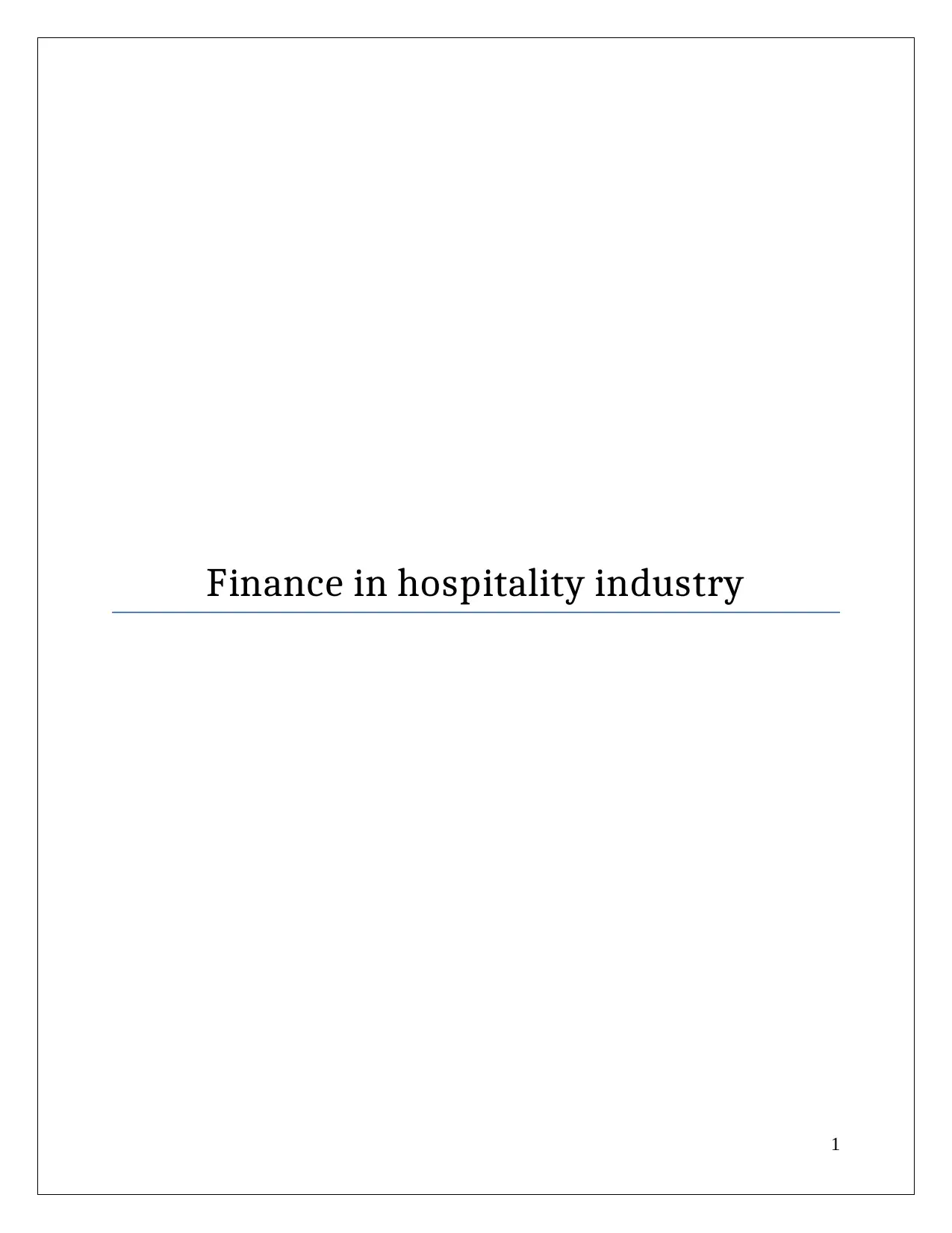
Finance in hospitality industry
1
1
Paraphrase This Document
Need a fresh take? Get an instant paraphrase of this document with our AI Paraphraser
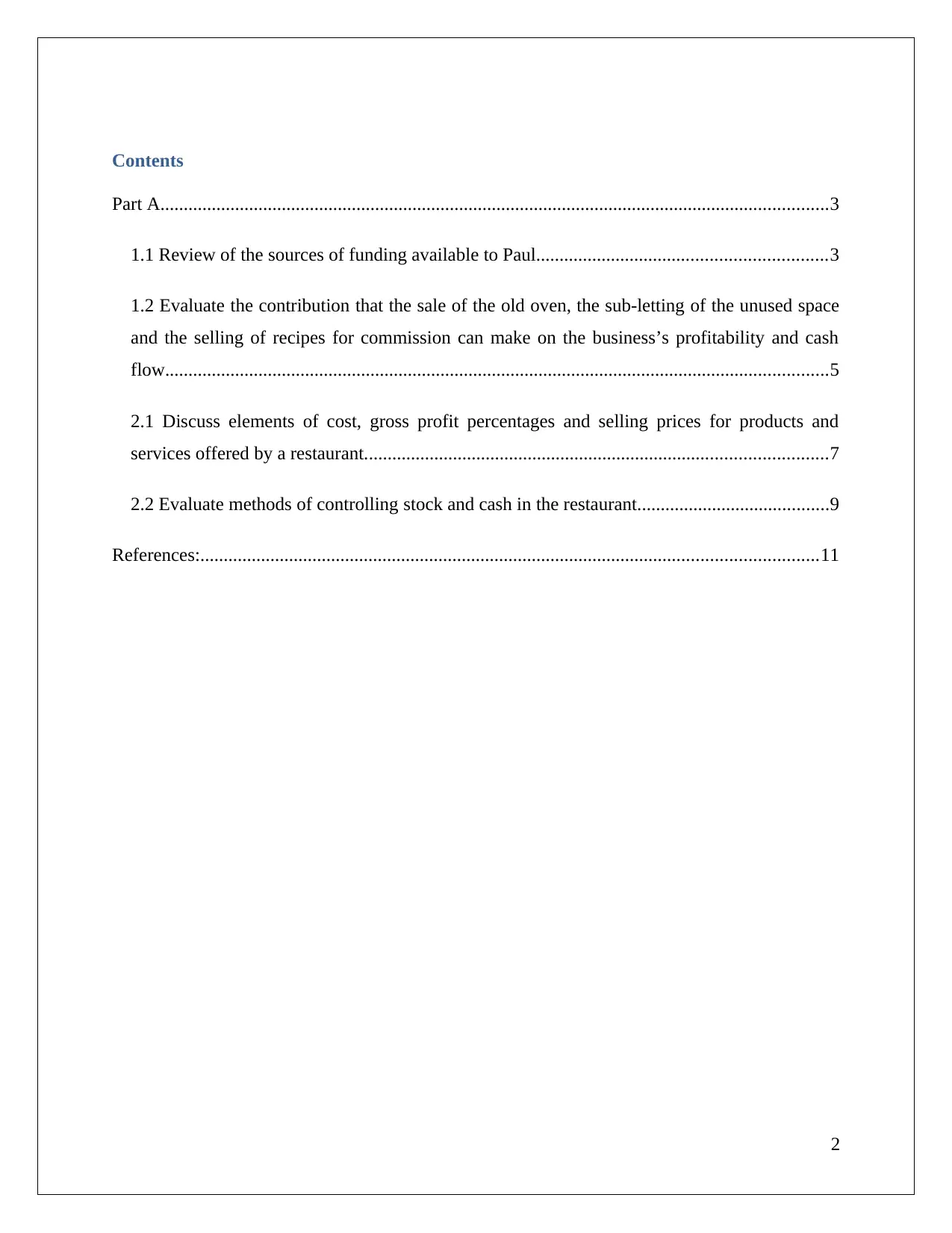
Contents
Part A...............................................................................................................................................3
1.1 Review of the sources of funding available to Paul..............................................................3
1.2 Evaluate the contribution that the sale of the old oven, the sub-letting of the unused space
and the selling of recipes for commission can make on the business’s profitability and cash
flow..............................................................................................................................................5
2.1 Discuss elements of cost, gross profit percentages and selling prices for products and
services offered by a restaurant...................................................................................................7
2.2 Evaluate methods of controlling stock and cash in the restaurant.........................................9
References:....................................................................................................................................11
2
Part A...............................................................................................................................................3
1.1 Review of the sources of funding available to Paul..............................................................3
1.2 Evaluate the contribution that the sale of the old oven, the sub-letting of the unused space
and the selling of recipes for commission can make on the business’s profitability and cash
flow..............................................................................................................................................5
2.1 Discuss elements of cost, gross profit percentages and selling prices for products and
services offered by a restaurant...................................................................................................7
2.2 Evaluate methods of controlling stock and cash in the restaurant.........................................9
References:....................................................................................................................................11
2
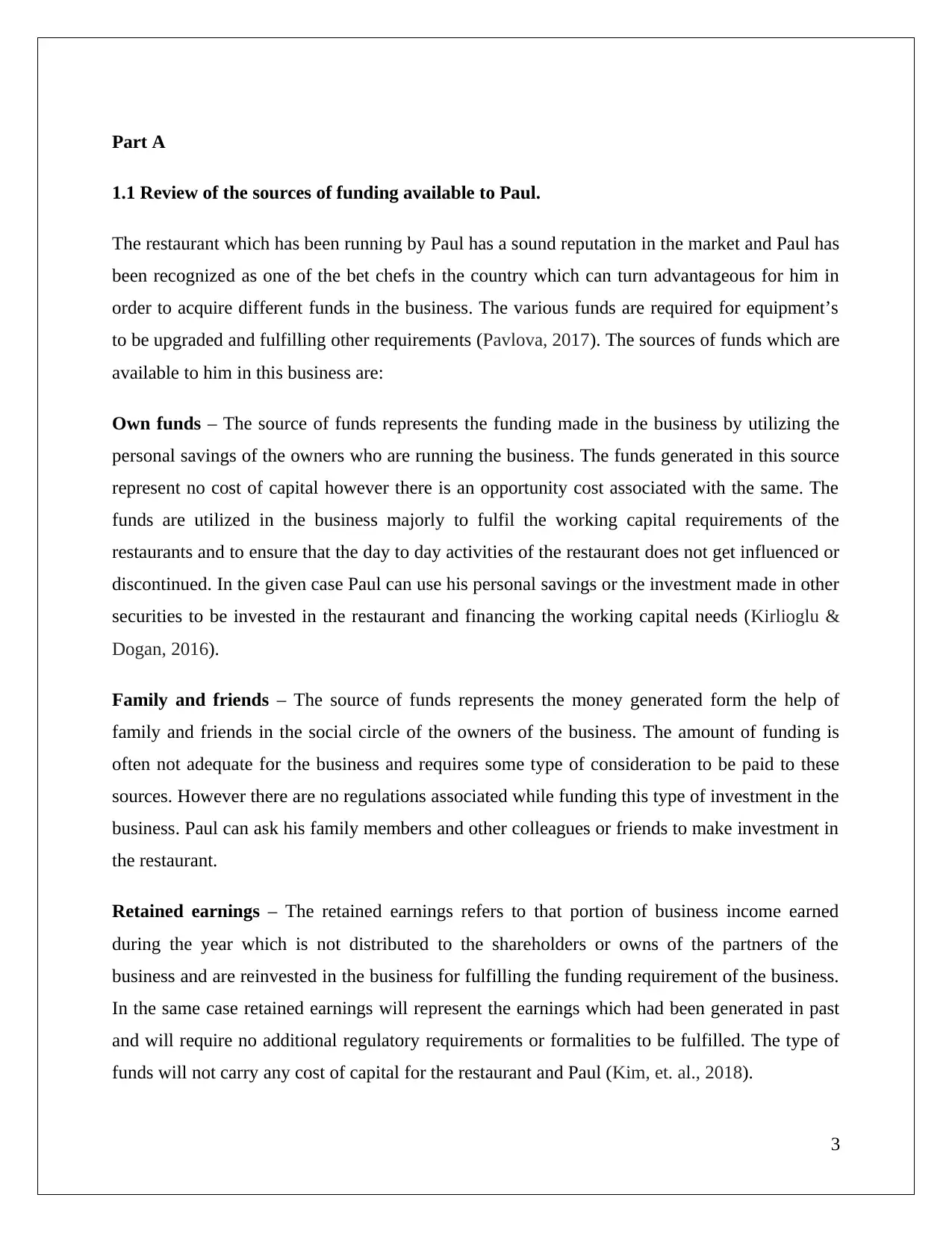
Part A
1.1 Review of the sources of funding available to Paul.
The restaurant which has been running by Paul has a sound reputation in the market and Paul has
been recognized as one of the bet chefs in the country which can turn advantageous for him in
order to acquire different funds in the business. The various funds are required for equipment’s
to be upgraded and fulfilling other requirements (Pavlova, 2017). The sources of funds which are
available to him in this business are:
Own funds – The source of funds represents the funding made in the business by utilizing the
personal savings of the owners who are running the business. The funds generated in this source
represent no cost of capital however there is an opportunity cost associated with the same. The
funds are utilized in the business majorly to fulfil the working capital requirements of the
restaurants and to ensure that the day to day activities of the restaurant does not get influenced or
discontinued. In the given case Paul can use his personal savings or the investment made in other
securities to be invested in the restaurant and financing the working capital needs (Kirlioglu &
Dogan, 2016).
Family and friends – The source of funds represents the money generated form the help of
family and friends in the social circle of the owners of the business. The amount of funding is
often not adequate for the business and requires some type of consideration to be paid to these
sources. However there are no regulations associated while funding this type of investment in the
business. Paul can ask his family members and other colleagues or friends to make investment in
the restaurant.
Retained earnings – The retained earnings refers to that portion of business income earned
during the year which is not distributed to the shareholders or owns of the partners of the
business and are reinvested in the business for fulfilling the funding requirement of the business.
In the same case retained earnings will represent the earnings which had been generated in past
and will require no additional regulatory requirements or formalities to be fulfilled. The type of
funds will not carry any cost of capital for the restaurant and Paul (Kim, et. al., 2018).
3
1.1 Review of the sources of funding available to Paul.
The restaurant which has been running by Paul has a sound reputation in the market and Paul has
been recognized as one of the bet chefs in the country which can turn advantageous for him in
order to acquire different funds in the business. The various funds are required for equipment’s
to be upgraded and fulfilling other requirements (Pavlova, 2017). The sources of funds which are
available to him in this business are:
Own funds – The source of funds represents the funding made in the business by utilizing the
personal savings of the owners who are running the business. The funds generated in this source
represent no cost of capital however there is an opportunity cost associated with the same. The
funds are utilized in the business majorly to fulfil the working capital requirements of the
restaurants and to ensure that the day to day activities of the restaurant does not get influenced or
discontinued. In the given case Paul can use his personal savings or the investment made in other
securities to be invested in the restaurant and financing the working capital needs (Kirlioglu &
Dogan, 2016).
Family and friends – The source of funds represents the money generated form the help of
family and friends in the social circle of the owners of the business. The amount of funding is
often not adequate for the business and requires some type of consideration to be paid to these
sources. However there are no regulations associated while funding this type of investment in the
business. Paul can ask his family members and other colleagues or friends to make investment in
the restaurant.
Retained earnings – The retained earnings refers to that portion of business income earned
during the year which is not distributed to the shareholders or owns of the partners of the
business and are reinvested in the business for fulfilling the funding requirement of the business.
In the same case retained earnings will represent the earnings which had been generated in past
and will require no additional regulatory requirements or formalities to be fulfilled. The type of
funds will not carry any cost of capital for the restaurant and Paul (Kim, et. al., 2018).
3
⊘ This is a preview!⊘
Do you want full access?
Subscribe today to unlock all pages.

Trusted by 1+ million students worldwide
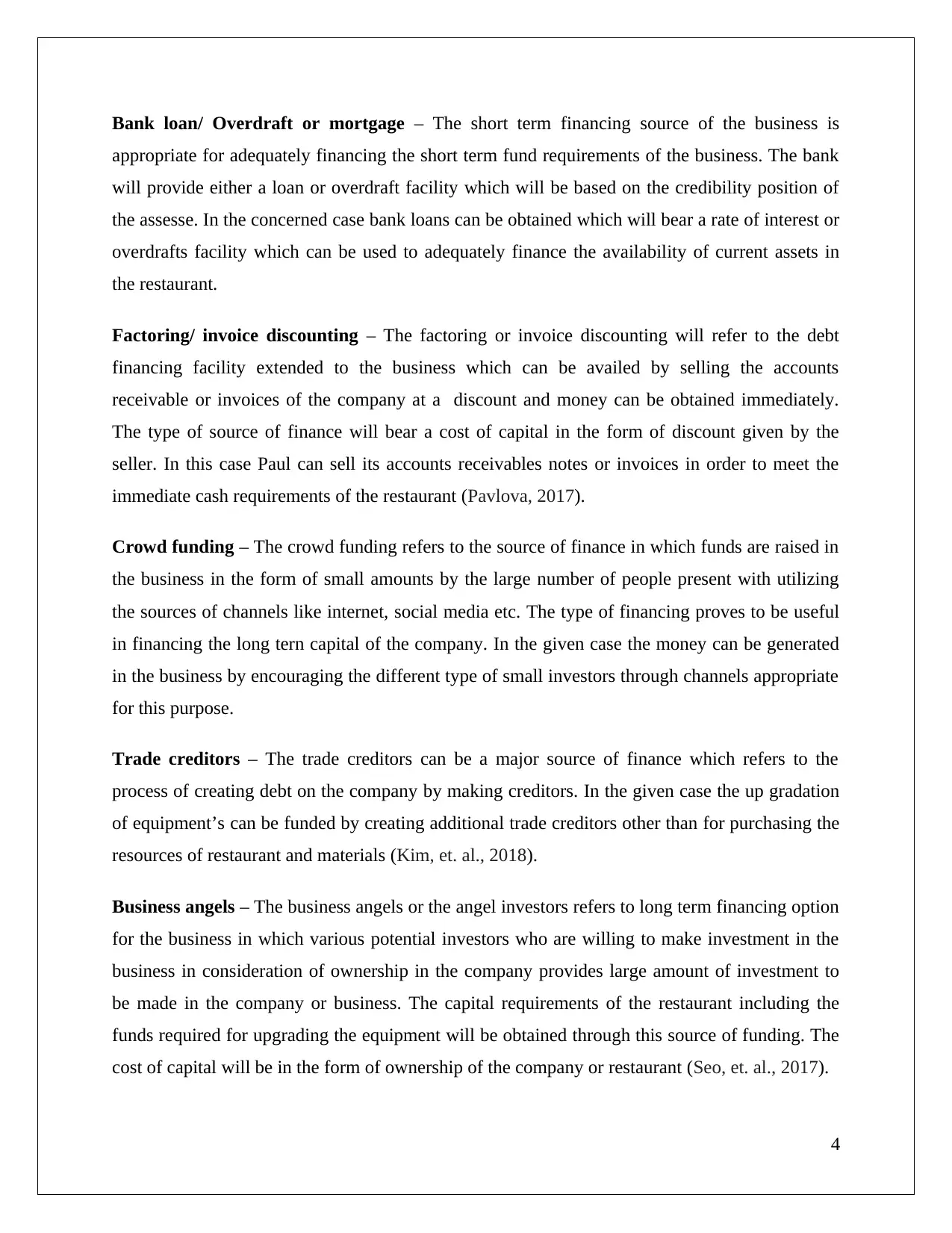
Bank loan/ Overdraft or mortgage – The short term financing source of the business is
appropriate for adequately financing the short term fund requirements of the business. The bank
will provide either a loan or overdraft facility which will be based on the credibility position of
the assesse. In the concerned case bank loans can be obtained which will bear a rate of interest or
overdrafts facility which can be used to adequately finance the availability of current assets in
the restaurant.
Factoring/ invoice discounting – The factoring or invoice discounting will refer to the debt
financing facility extended to the business which can be availed by selling the accounts
receivable or invoices of the company at a discount and money can be obtained immediately.
The type of source of finance will bear a cost of capital in the form of discount given by the
seller. In this case Paul can sell its accounts receivables notes or invoices in order to meet the
immediate cash requirements of the restaurant (Pavlova, 2017).
Crowd funding – The crowd funding refers to the source of finance in which funds are raised in
the business in the form of small amounts by the large number of people present with utilizing
the sources of channels like internet, social media etc. The type of financing proves to be useful
in financing the long tern capital of the company. In the given case the money can be generated
in the business by encouraging the different type of small investors through channels appropriate
for this purpose.
Trade creditors – The trade creditors can be a major source of finance which refers to the
process of creating debt on the company by making creditors. In the given case the up gradation
of equipment’s can be funded by creating additional trade creditors other than for purchasing the
resources of restaurant and materials (Kim, et. al., 2018).
Business angels – The business angels or the angel investors refers to long term financing option
for the business in which various potential investors who are willing to make investment in the
business in consideration of ownership in the company provides large amount of investment to
be made in the company or business. The capital requirements of the restaurant including the
funds required for upgrading the equipment will be obtained through this source of funding. The
cost of capital will be in the form of ownership of the company or restaurant (Seo, et. al., 2017).
4
appropriate for adequately financing the short term fund requirements of the business. The bank
will provide either a loan or overdraft facility which will be based on the credibility position of
the assesse. In the concerned case bank loans can be obtained which will bear a rate of interest or
overdrafts facility which can be used to adequately finance the availability of current assets in
the restaurant.
Factoring/ invoice discounting – The factoring or invoice discounting will refer to the debt
financing facility extended to the business which can be availed by selling the accounts
receivable or invoices of the company at a discount and money can be obtained immediately.
The type of source of finance will bear a cost of capital in the form of discount given by the
seller. In this case Paul can sell its accounts receivables notes or invoices in order to meet the
immediate cash requirements of the restaurant (Pavlova, 2017).
Crowd funding – The crowd funding refers to the source of finance in which funds are raised in
the business in the form of small amounts by the large number of people present with utilizing
the sources of channels like internet, social media etc. The type of financing proves to be useful
in financing the long tern capital of the company. In the given case the money can be generated
in the business by encouraging the different type of small investors through channels appropriate
for this purpose.
Trade creditors – The trade creditors can be a major source of finance which refers to the
process of creating debt on the company by making creditors. In the given case the up gradation
of equipment’s can be funded by creating additional trade creditors other than for purchasing the
resources of restaurant and materials (Kim, et. al., 2018).
Business angels – The business angels or the angel investors refers to long term financing option
for the business in which various potential investors who are willing to make investment in the
business in consideration of ownership in the company provides large amount of investment to
be made in the company or business. The capital requirements of the restaurant including the
funds required for upgrading the equipment will be obtained through this source of funding. The
cost of capital will be in the form of ownership of the company or restaurant (Seo, et. al., 2017).
4
Paraphrase This Document
Need a fresh take? Get an instant paraphrase of this document with our AI Paraphraser
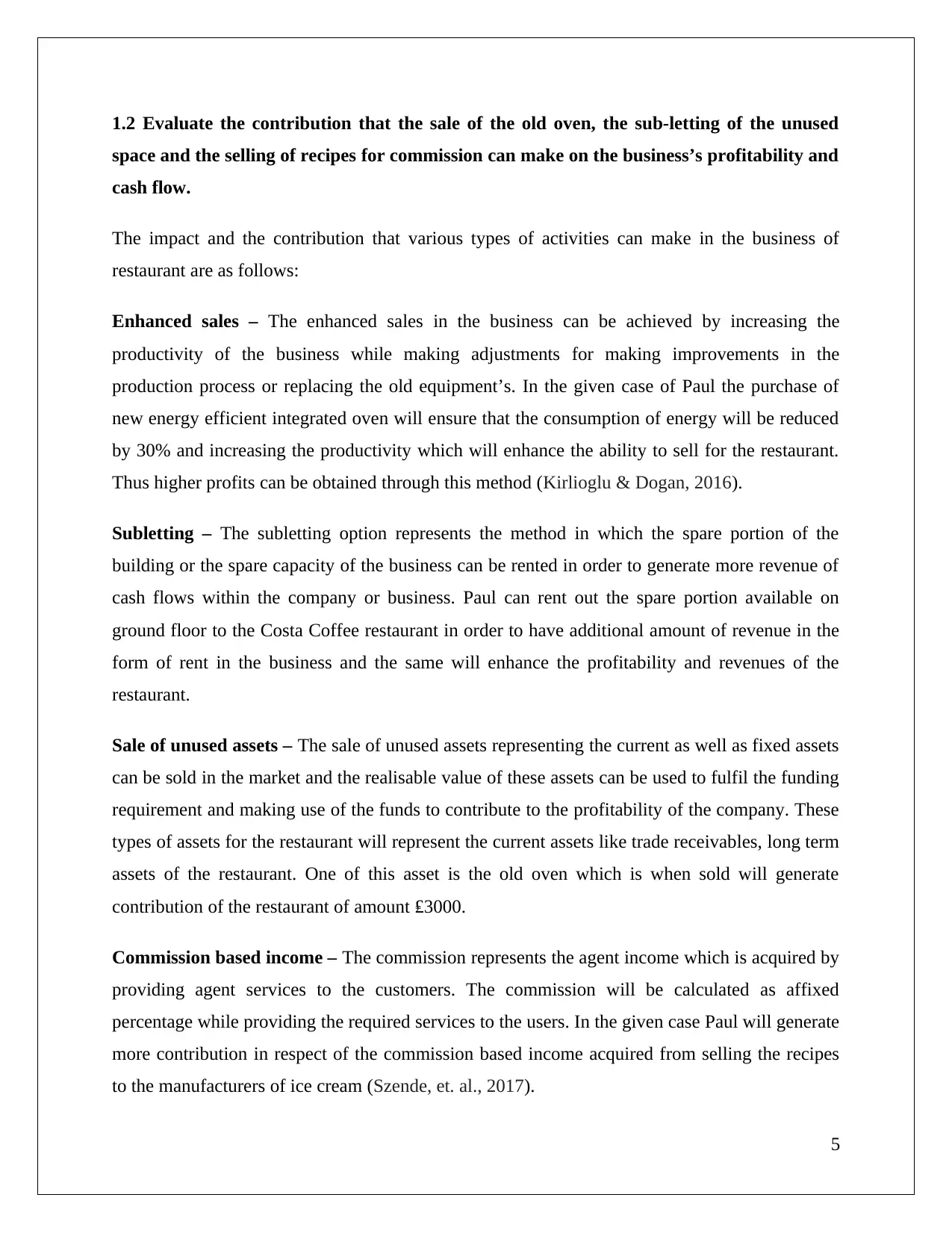
1.2 Evaluate the contribution that the sale of the old oven, the sub-letting of the unused
space and the selling of recipes for commission can make on the business’s profitability and
cash flow.
The impact and the contribution that various types of activities can make in the business of
restaurant are as follows:
Enhanced sales – The enhanced sales in the business can be achieved by increasing the
productivity of the business while making adjustments for making improvements in the
production process or replacing the old equipment’s. In the given case of Paul the purchase of
new energy efficient integrated oven will ensure that the consumption of energy will be reduced
by 30% and increasing the productivity which will enhance the ability to sell for the restaurant.
Thus higher profits can be obtained through this method (Kirlioglu & Dogan, 2016).
Subletting – The subletting option represents the method in which the spare portion of the
building or the spare capacity of the business can be rented in order to generate more revenue of
cash flows within the company or business. Paul can rent out the spare portion available on
ground floor to the Costa Coffee restaurant in order to have additional amount of revenue in the
form of rent in the business and the same will enhance the profitability and revenues of the
restaurant.
Sale of unused assets – The sale of unused assets representing the current as well as fixed assets
can be sold in the market and the realisable value of these assets can be used to fulfil the funding
requirement and making use of the funds to contribute to the profitability of the company. These
types of assets for the restaurant will represent the current assets like trade receivables, long term
assets of the restaurant. One of this asset is the old oven which is when sold will generate
contribution of the restaurant of amount ₤3000.
Commission based income – The commission represents the agent income which is acquired by
providing agent services to the customers. The commission will be calculated as affixed
percentage while providing the required services to the users. In the given case Paul will generate
more contribution in respect of the commission based income acquired from selling the recipes
to the manufacturers of ice cream (Szende, et. al., 2017).
5
space and the selling of recipes for commission can make on the business’s profitability and
cash flow.
The impact and the contribution that various types of activities can make in the business of
restaurant are as follows:
Enhanced sales – The enhanced sales in the business can be achieved by increasing the
productivity of the business while making adjustments for making improvements in the
production process or replacing the old equipment’s. In the given case of Paul the purchase of
new energy efficient integrated oven will ensure that the consumption of energy will be reduced
by 30% and increasing the productivity which will enhance the ability to sell for the restaurant.
Thus higher profits can be obtained through this method (Kirlioglu & Dogan, 2016).
Subletting – The subletting option represents the method in which the spare portion of the
building or the spare capacity of the business can be rented in order to generate more revenue of
cash flows within the company or business. Paul can rent out the spare portion available on
ground floor to the Costa Coffee restaurant in order to have additional amount of revenue in the
form of rent in the business and the same will enhance the profitability and revenues of the
restaurant.
Sale of unused assets – The sale of unused assets representing the current as well as fixed assets
can be sold in the market and the realisable value of these assets can be used to fulfil the funding
requirement and making use of the funds to contribute to the profitability of the company. These
types of assets for the restaurant will represent the current assets like trade receivables, long term
assets of the restaurant. One of this asset is the old oven which is when sold will generate
contribution of the restaurant of amount ₤3000.
Commission based income – The commission represents the agent income which is acquired by
providing agent services to the customers. The commission will be calculated as affixed
percentage while providing the required services to the users. In the given case Paul will generate
more contribution in respect of the commission based income acquired from selling the recipes
to the manufacturers of ice cream (Szende, et. al., 2017).
5
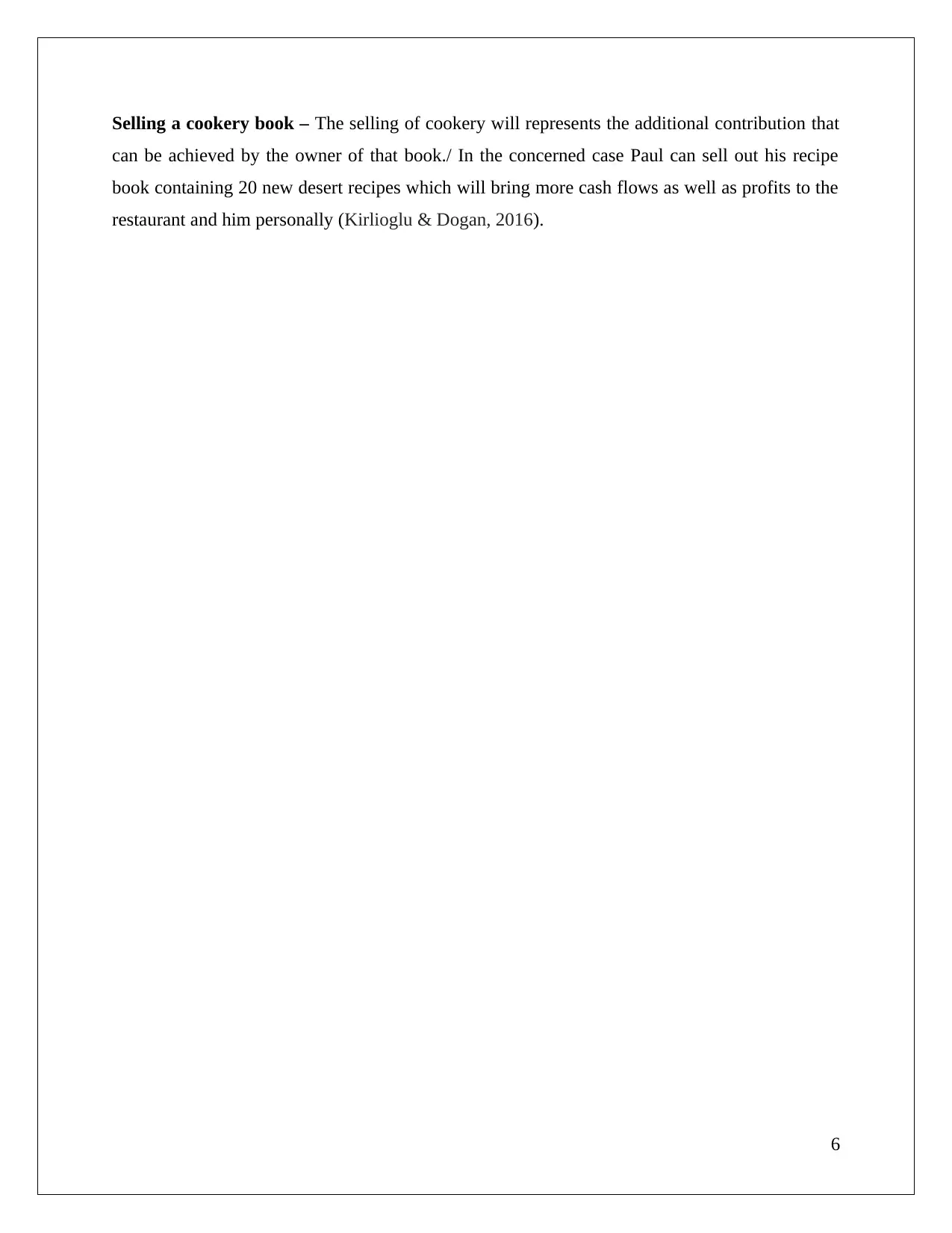
Selling a cookery book – The selling of cookery will represents the additional contribution that
can be achieved by the owner of that book./ In the concerned case Paul can sell out his recipe
book containing 20 new desert recipes which will bring more cash flows as well as profits to the
restaurant and him personally (Kirlioglu & Dogan, 2016).
6
can be achieved by the owner of that book./ In the concerned case Paul can sell out his recipe
book containing 20 new desert recipes which will bring more cash flows as well as profits to the
restaurant and him personally (Kirlioglu & Dogan, 2016).
6
⊘ This is a preview!⊘
Do you want full access?
Subscribe today to unlock all pages.

Trusted by 1+ million students worldwide
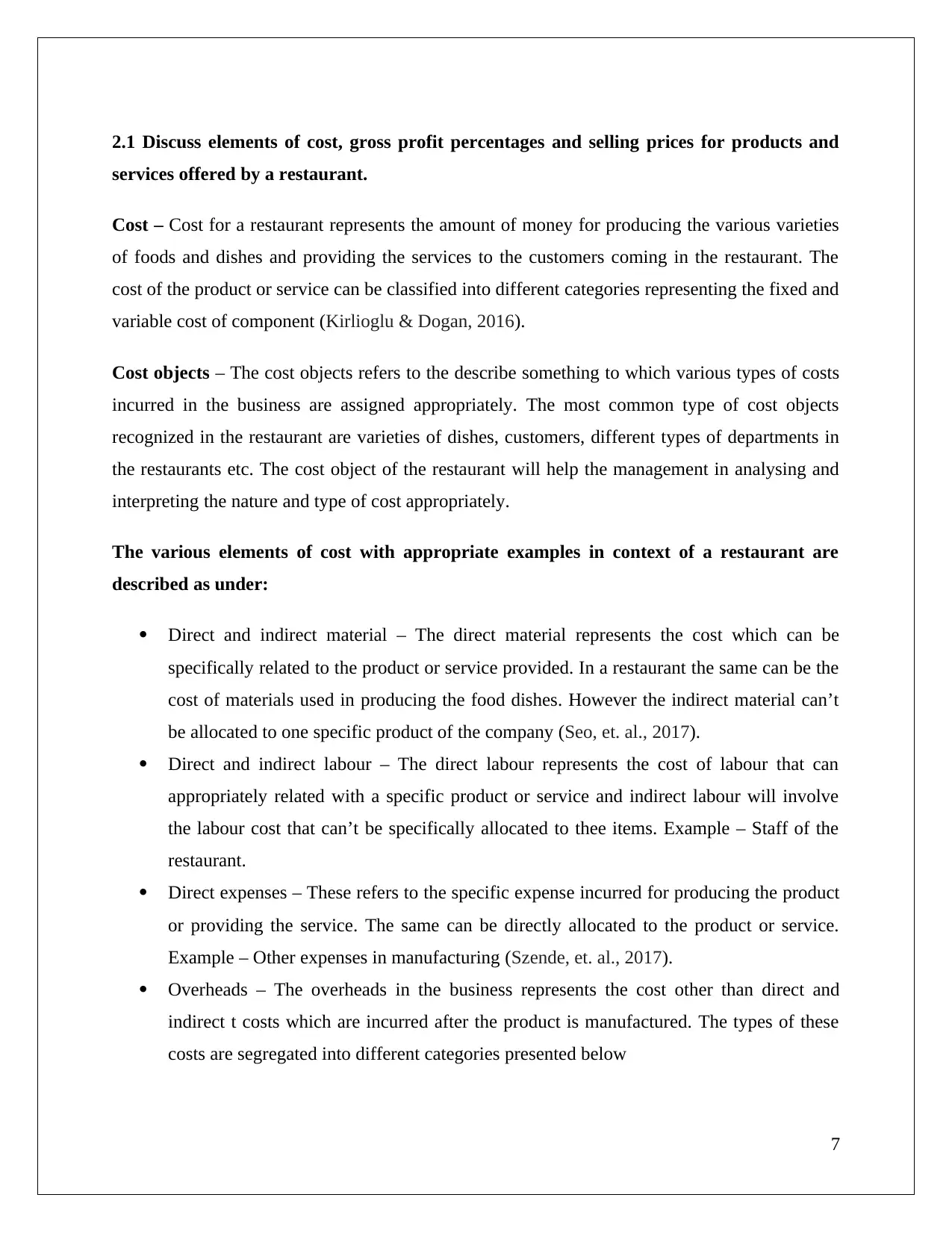
2.1 Discuss elements of cost, gross profit percentages and selling prices for products and
services offered by a restaurant.
Cost – Cost for a restaurant represents the amount of money for producing the various varieties
of foods and dishes and providing the services to the customers coming in the restaurant. The
cost of the product or service can be classified into different categories representing the fixed and
variable cost of component (Kirlioglu & Dogan, 2016).
Cost objects – The cost objects refers to the describe something to which various types of costs
incurred in the business are assigned appropriately. The most common type of cost objects
recognized in the restaurant are varieties of dishes, customers, different types of departments in
the restaurants etc. The cost object of the restaurant will help the management in analysing and
interpreting the nature and type of cost appropriately.
The various elements of cost with appropriate examples in context of a restaurant are
described as under:
Direct and indirect material – The direct material represents the cost which can be
specifically related to the product or service provided. In a restaurant the same can be the
cost of materials used in producing the food dishes. However the indirect material can’t
be allocated to one specific product of the company (Seo, et. al., 2017).
Direct and indirect labour – The direct labour represents the cost of labour that can
appropriately related with a specific product or service and indirect labour will involve
the labour cost that can’t be specifically allocated to thee items. Example – Staff of the
restaurant.
Direct expenses – These refers to the specific expense incurred for producing the product
or providing the service. The same can be directly allocated to the product or service.
Example – Other expenses in manufacturing (Szende, et. al., 2017).
Overheads – The overheads in the business represents the cost other than direct and
indirect t costs which are incurred after the product is manufactured. The types of these
costs are segregated into different categories presented below
7
services offered by a restaurant.
Cost – Cost for a restaurant represents the amount of money for producing the various varieties
of foods and dishes and providing the services to the customers coming in the restaurant. The
cost of the product or service can be classified into different categories representing the fixed and
variable cost of component (Kirlioglu & Dogan, 2016).
Cost objects – The cost objects refers to the describe something to which various types of costs
incurred in the business are assigned appropriately. The most common type of cost objects
recognized in the restaurant are varieties of dishes, customers, different types of departments in
the restaurants etc. The cost object of the restaurant will help the management in analysing and
interpreting the nature and type of cost appropriately.
The various elements of cost with appropriate examples in context of a restaurant are
described as under:
Direct and indirect material – The direct material represents the cost which can be
specifically related to the product or service provided. In a restaurant the same can be the
cost of materials used in producing the food dishes. However the indirect material can’t
be allocated to one specific product of the company (Seo, et. al., 2017).
Direct and indirect labour – The direct labour represents the cost of labour that can
appropriately related with a specific product or service and indirect labour will involve
the labour cost that can’t be specifically allocated to thee items. Example – Staff of the
restaurant.
Direct expenses – These refers to the specific expense incurred for producing the product
or providing the service. The same can be directly allocated to the product or service.
Example – Other expenses in manufacturing (Szende, et. al., 2017).
Overheads – The overheads in the business represents the cost other than direct and
indirect t costs which are incurred after the product is manufactured. The types of these
costs are segregated into different categories presented below
7
Paraphrase This Document
Need a fresh take? Get an instant paraphrase of this document with our AI Paraphraser
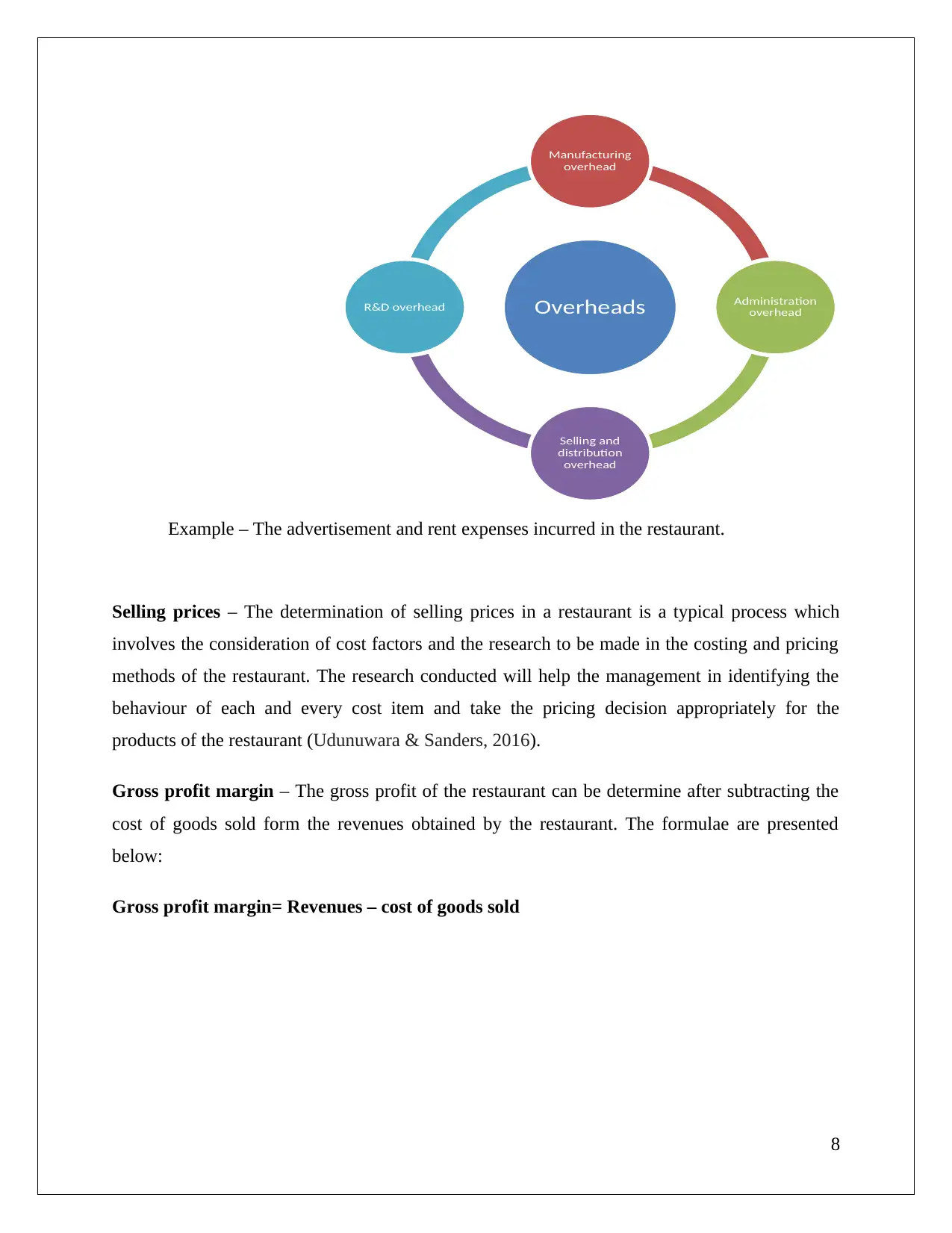
Example – The advertisement and rent expenses incurred in the restaurant.
Selling prices – The determination of selling prices in a restaurant is a typical process which
involves the consideration of cost factors and the research to be made in the costing and pricing
methods of the restaurant. The research conducted will help the management in identifying the
behaviour of each and every cost item and take the pricing decision appropriately for the
products of the restaurant (Udunuwara & Sanders, 2016).
Gross profit margin – The gross profit of the restaurant can be determine after subtracting the
cost of goods sold form the revenues obtained by the restaurant. The formulae are presented
below:
Gross profit margin= Revenues – cost of goods sold
8
Overheads
Manufacturing
overhead
Administration
overhead
Selling and
distribution
overhead
R&D overhead
Selling prices – The determination of selling prices in a restaurant is a typical process which
involves the consideration of cost factors and the research to be made in the costing and pricing
methods of the restaurant. The research conducted will help the management in identifying the
behaviour of each and every cost item and take the pricing decision appropriately for the
products of the restaurant (Udunuwara & Sanders, 2016).
Gross profit margin – The gross profit of the restaurant can be determine after subtracting the
cost of goods sold form the revenues obtained by the restaurant. The formulae are presented
below:
Gross profit margin= Revenues – cost of goods sold
8
Overheads
Manufacturing
overhead
Administration
overhead
Selling and
distribution
overhead
R&D overhead
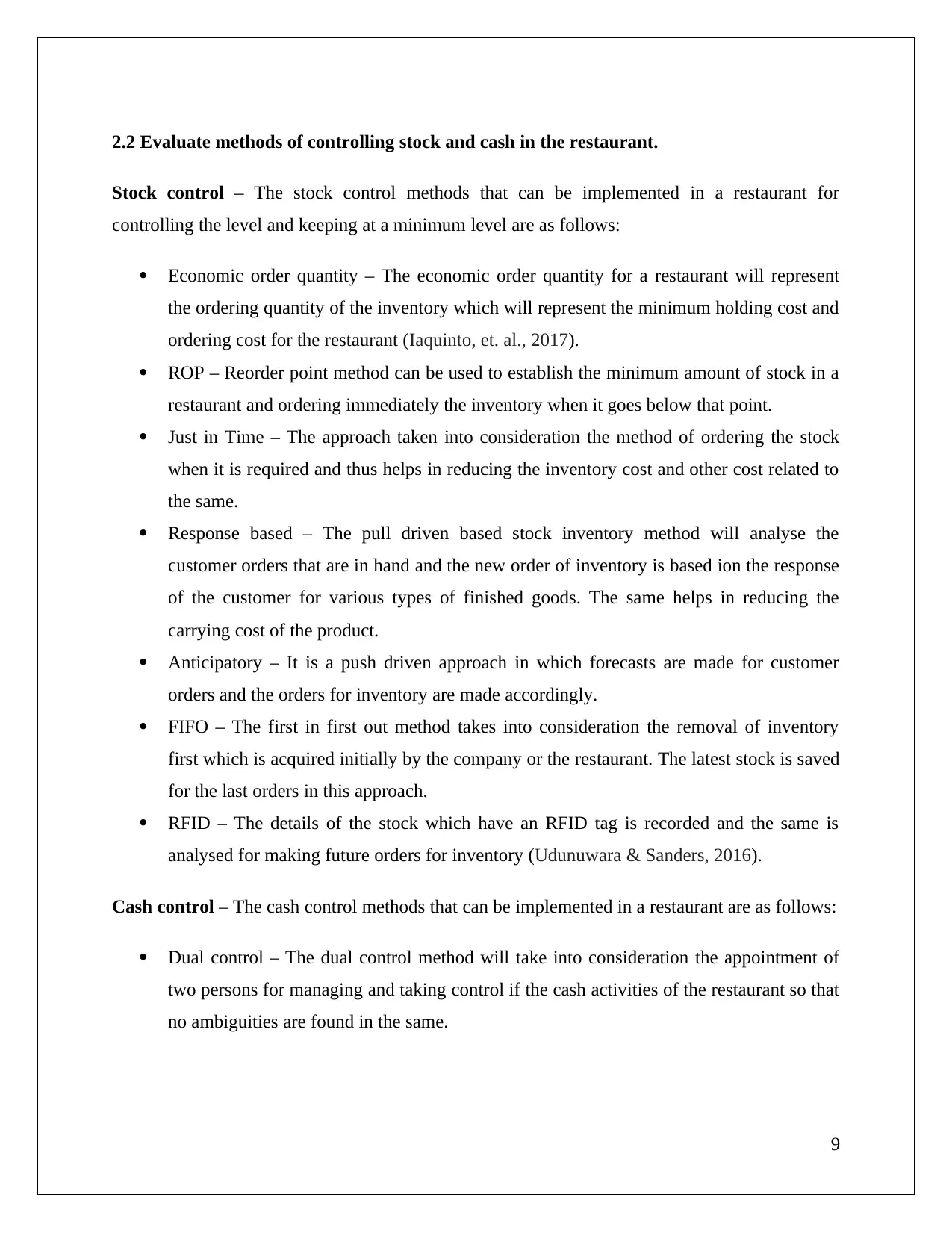
2.2 Evaluate methods of controlling stock and cash in the restaurant.
Stock control – The stock control methods that can be implemented in a restaurant for
controlling the level and keeping at a minimum level are as follows:
Economic order quantity – The economic order quantity for a restaurant will represent
the ordering quantity of the inventory which will represent the minimum holding cost and
ordering cost for the restaurant (Iaquinto, et. al., 2017).
ROP – Reorder point method can be used to establish the minimum amount of stock in a
restaurant and ordering immediately the inventory when it goes below that point.
Just in Time – The approach taken into consideration the method of ordering the stock
when it is required and thus helps in reducing the inventory cost and other cost related to
the same.
Response based – The pull driven based stock inventory method will analyse the
customer orders that are in hand and the new order of inventory is based ion the response
of the customer for various types of finished goods. The same helps in reducing the
carrying cost of the product.
Anticipatory – It is a push driven approach in which forecasts are made for customer
orders and the orders for inventory are made accordingly.
FIFO – The first in first out method takes into consideration the removal of inventory
first which is acquired initially by the company or the restaurant. The latest stock is saved
for the last orders in this approach.
RFID – The details of the stock which have an RFID tag is recorded and the same is
analysed for making future orders for inventory (Udunuwara & Sanders, 2016).
Cash control – The cash control methods that can be implemented in a restaurant are as follows:
Dual control – The dual control method will take into consideration the appointment of
two persons for managing and taking control if the cash activities of the restaurant so that
no ambiguities are found in the same.
9
Stock control – The stock control methods that can be implemented in a restaurant for
controlling the level and keeping at a minimum level are as follows:
Economic order quantity – The economic order quantity for a restaurant will represent
the ordering quantity of the inventory which will represent the minimum holding cost and
ordering cost for the restaurant (Iaquinto, et. al., 2017).
ROP – Reorder point method can be used to establish the minimum amount of stock in a
restaurant and ordering immediately the inventory when it goes below that point.
Just in Time – The approach taken into consideration the method of ordering the stock
when it is required and thus helps in reducing the inventory cost and other cost related to
the same.
Response based – The pull driven based stock inventory method will analyse the
customer orders that are in hand and the new order of inventory is based ion the response
of the customer for various types of finished goods. The same helps in reducing the
carrying cost of the product.
Anticipatory – It is a push driven approach in which forecasts are made for customer
orders and the orders for inventory are made accordingly.
FIFO – The first in first out method takes into consideration the removal of inventory
first which is acquired initially by the company or the restaurant. The latest stock is saved
for the last orders in this approach.
RFID – The details of the stock which have an RFID tag is recorded and the same is
analysed for making future orders for inventory (Udunuwara & Sanders, 2016).
Cash control – The cash control methods that can be implemented in a restaurant are as follows:
Dual control – The dual control method will take into consideration the appointment of
two persons for managing and taking control if the cash activities of the restaurant so that
no ambiguities are found in the same.
9
⊘ This is a preview!⊘
Do you want full access?
Subscribe today to unlock all pages.

Trusted by 1+ million students worldwide
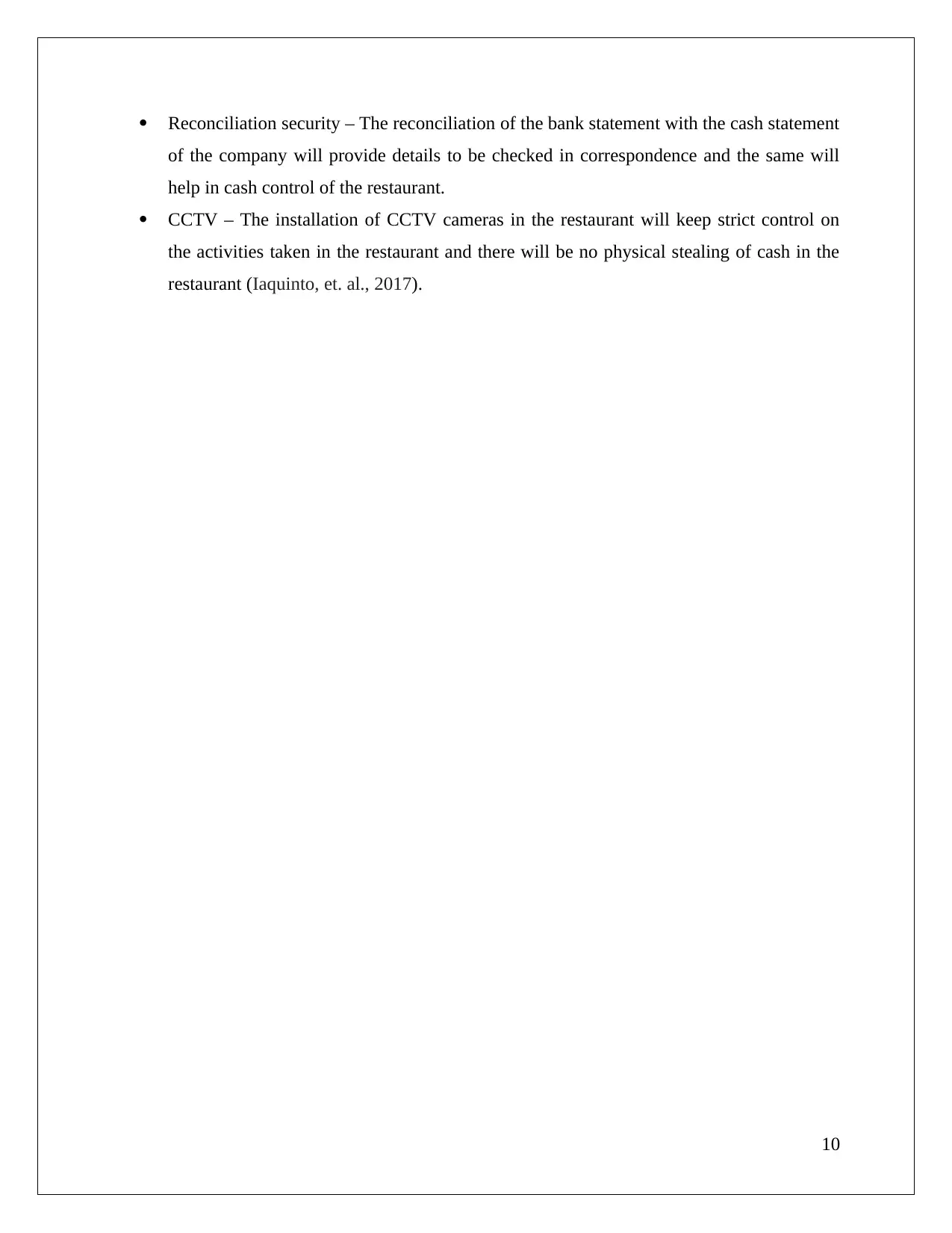
Reconciliation security – The reconciliation of the bank statement with the cash statement
of the company will provide details to be checked in correspondence and the same will
help in cash control of the restaurant.
CCTV – The installation of CCTV cameras in the restaurant will keep strict control on
the activities taken in the restaurant and there will be no physical stealing of cash in the
restaurant (Iaquinto, et. al., 2017).
10
of the company will provide details to be checked in correspondence and the same will
help in cash control of the restaurant.
CCTV – The installation of CCTV cameras in the restaurant will keep strict control on
the activities taken in the restaurant and there will be no physical stealing of cash in the
restaurant (Iaquinto, et. al., 2017).
10
Paraphrase This Document
Need a fresh take? Get an instant paraphrase of this document with our AI Paraphraser
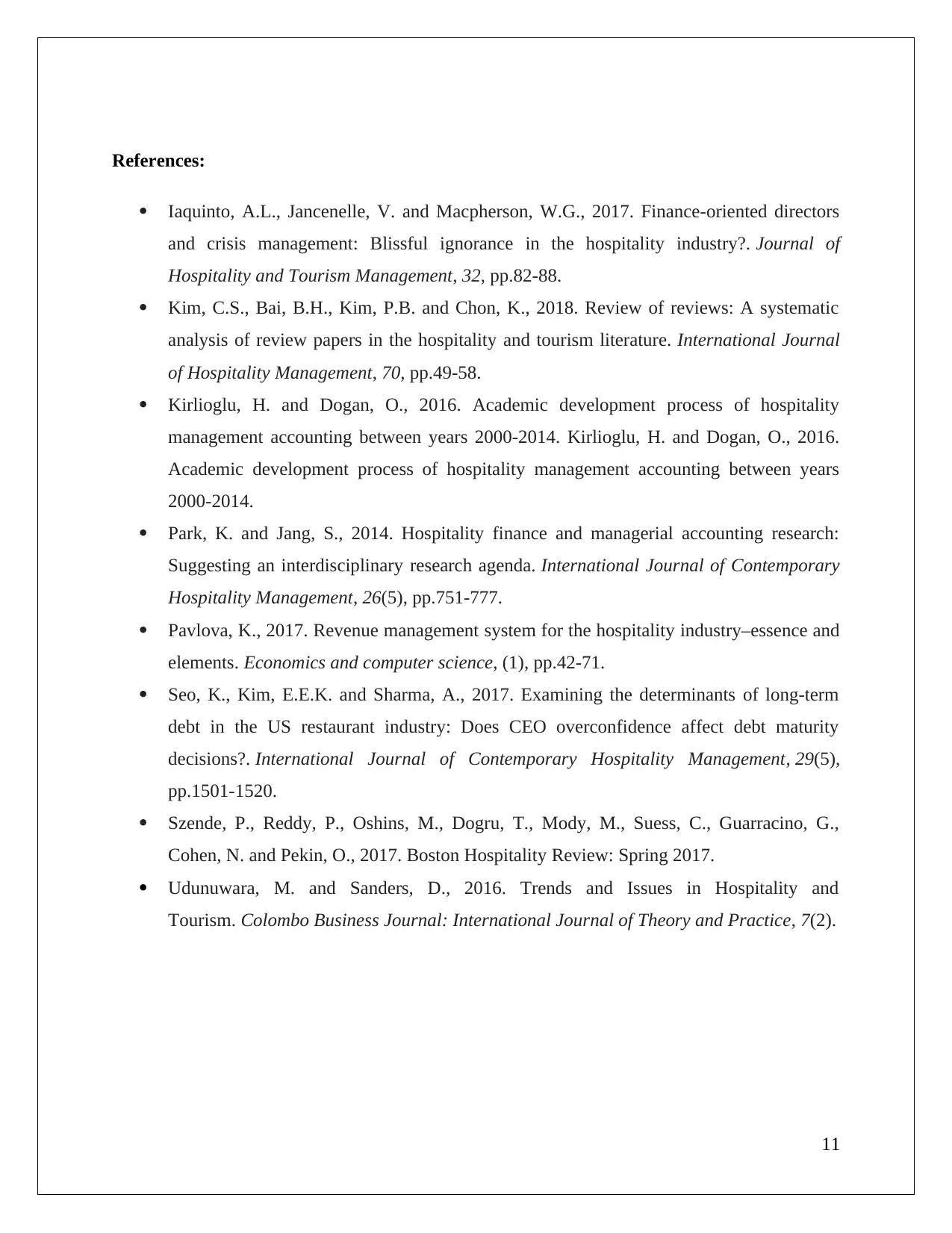
References:
Iaquinto, A.L., Jancenelle, V. and Macpherson, W.G., 2017. Finance-oriented directors
and crisis management: Blissful ignorance in the hospitality industry?. Journal of
Hospitality and Tourism Management, 32, pp.82-88.
Kim, C.S., Bai, B.H., Kim, P.B. and Chon, K., 2018. Review of reviews: A systematic
analysis of review papers in the hospitality and tourism literature. International Journal
of Hospitality Management, 70, pp.49-58.
Kirlioglu, H. and Dogan, O., 2016. Academic development process of hospitality
management accounting between years 2000-2014. Kirlioglu, H. and Dogan, O., 2016.
Academic development process of hospitality management accounting between years
2000-2014.
Park, K. and Jang, S., 2014. Hospitality finance and managerial accounting research:
Suggesting an interdisciplinary research agenda. International Journal of Contemporary
Hospitality Management, 26(5), pp.751-777.
Pavlova, K., 2017. Revenue management system for the hospitality industry–essence and
elements. Economics and computer science, (1), pp.42-71.
Seo, K., Kim, E.E.K. and Sharma, A., 2017. Examining the determinants of long-term
debt in the US restaurant industry: Does CEO overconfidence affect debt maturity
decisions?. International Journal of Contemporary Hospitality Management, 29(5),
pp.1501-1520.
Szende, P., Reddy, P., Oshins, M., Dogru, T., Mody, M., Suess, C., Guarracino, G.,
Cohen, N. and Pekin, O., 2017. Boston Hospitality Review: Spring 2017.
Udunuwara, M. and Sanders, D., 2016. Trends and Issues in Hospitality and
Tourism. Colombo Business Journal: International Journal of Theory and Practice, 7(2).
11
Iaquinto, A.L., Jancenelle, V. and Macpherson, W.G., 2017. Finance-oriented directors
and crisis management: Blissful ignorance in the hospitality industry?. Journal of
Hospitality and Tourism Management, 32, pp.82-88.
Kim, C.S., Bai, B.H., Kim, P.B. and Chon, K., 2018. Review of reviews: A systematic
analysis of review papers in the hospitality and tourism literature. International Journal
of Hospitality Management, 70, pp.49-58.
Kirlioglu, H. and Dogan, O., 2016. Academic development process of hospitality
management accounting between years 2000-2014. Kirlioglu, H. and Dogan, O., 2016.
Academic development process of hospitality management accounting between years
2000-2014.
Park, K. and Jang, S., 2014. Hospitality finance and managerial accounting research:
Suggesting an interdisciplinary research agenda. International Journal of Contemporary
Hospitality Management, 26(5), pp.751-777.
Pavlova, K., 2017. Revenue management system for the hospitality industry–essence and
elements. Economics and computer science, (1), pp.42-71.
Seo, K., Kim, E.E.K. and Sharma, A., 2017. Examining the determinants of long-term
debt in the US restaurant industry: Does CEO overconfidence affect debt maturity
decisions?. International Journal of Contemporary Hospitality Management, 29(5),
pp.1501-1520.
Szende, P., Reddy, P., Oshins, M., Dogru, T., Mody, M., Suess, C., Guarracino, G.,
Cohen, N. and Pekin, O., 2017. Boston Hospitality Review: Spring 2017.
Udunuwara, M. and Sanders, D., 2016. Trends and Issues in Hospitality and
Tourism. Colombo Business Journal: International Journal of Theory and Practice, 7(2).
11
1 out of 11
Related Documents
Your All-in-One AI-Powered Toolkit for Academic Success.
+13062052269
info@desklib.com
Available 24*7 on WhatsApp / Email
![[object Object]](/_next/static/media/star-bottom.7253800d.svg)
Unlock your academic potential
Copyright © 2020–2025 A2Z Services. All Rights Reserved. Developed and managed by ZUCOL.





